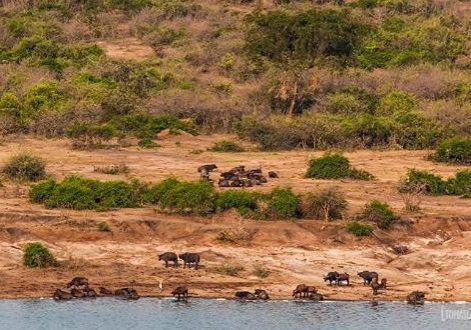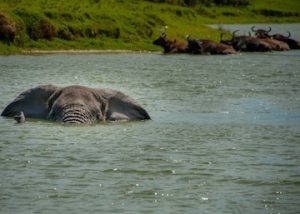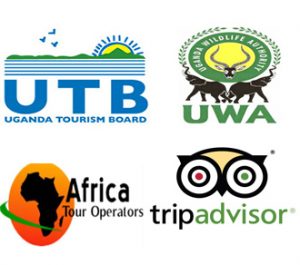THE MWEYA PENINSULA AT THE QUEEN ELIZABETH NATIONAL PARK
Situated on the northern bank of the stunning Kazinga Channel where it merges with Lake Edward, the Mweya Peninsula region joins the channel track distance down to the main gate of Katunguru from where it transversely moves to the Kabatoro door; with a very thick ground cover and vegetation that is ruled by the Candelabra Thorn. The dense vegetation cover makes the viewing of game quite difficult however, there are other paths that are kept well thus making it a whole lot easier for game drives. Following the park’s paths might be tiresome sometimes which may lead you to forget the path you took but the Channel track and the main street in the park are both obvious features where unique tracks for game drives come together.

Most of the travelers that come visiting the Mweya Peninsular take part in a 2-hour boat cruise on the Kazinga Channel. This boat is a 20 seater mechanized boat run by the park authorities and this has 2 rides that happen in the morning and late afternoon respectively. Sometimes however, the boat may go 3 times a day if there is an overflow of guests who would wish to participate in this activity. For bookings, there is an office in Mweya that helps fix you to a group that pre-booked and is ready to float the channels waters.
While at the mainland in Mweya, appreciate the astonishing viewpoints that are above the water with sights that extend all the way to the Rwenzori Mountains. This Peninsular is one of the finest places where one can catch sight of a leopard. It is also a point where the beautiful northern piece of the north sector of the national park meets.

THE MWEYA PENINSULAR HISTORY
The principal confirmation of presence of people at Mweya dates back to near 50,000 years back, and this range has probably evolved throughout the previous thousand years. The major and not very old record of this place was given by an investigate Stanley, who reached on the edge of the Mweya landmass in the long stretch of July in 1889 and he recorded that he couldn’t see anything besides an “indistinct void”, most presumably because of the smoke from the hedge clearing fires. Mweya had just 81 hovels around then and had a lot of sheep in addition to goats; however, in 1891 when Lugard achieved this promontory, the town was really betrayed, potentially before Lugard’s gathering. As the century passed by, the landmass and additionally the encompassing spots where surrendered after scourges of resting ailment in addition to rinderpest. Really the promontory remained shut to every single human settlement until the point when it was later announced an area of the Queen Elizabeth National Park in 1952, despite the fact that by that statement, a few people had begun settling inside the Mweya. The Mweya town today has an expected populace of 400 individuals, and is today the fundamental center for traveler exercises inside the Park.
There is an extravagant Uganda safari hold up here normal to sightseers called the Mweya Safari Lodge, which is found on the northern end of the Peninsula and offers a fantastic sight over the nearby Lake Edward.

